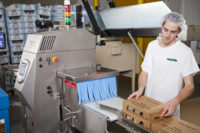Air quality is a major topic in everyone’s mind these days. As 3-A Sanitary Standards revises all of its individual equipment standards and system practices to use the broadened scope of its 3-A Sanitary Standard for General Requirements, ANSI/3-A 00-01-2018 (GR), existing industries such as pet food, personal care products, and beverage/bottling — and emerging technologies such as robotics and robotic automation systems — are lining up to assist with the revision of these important systems practices.
Within the new, expanded scope of the General Requirements Standard, Working Group 12 (Plant Support Systems) now includes a growing number of new major food plant manufacturers and food-processing equipment-industry stakeholder volunteers who are providing guidance for air quality and air supply systems.
Defining air supply systems
The working group and its volunteer members are finding an increased need to use 3-A Accepted Practice for Plant Environmental Air Quality, Number 612-00 as a normative reference for other systems and equipment that require specialized air supply systems for recommended applications. That standard also serves as a normative reference for the ongoing revision of 3-A Accepted Practice for Supplying Air Under Pressure in Contact with Products and Product Contact Surfaces, Number 604-05. The former is an important accepted practice because it provides definitions for common plant air supply systems and their components.
These air supply systems, subsystems, and their component materials are defined as well. The filter media must “consist of materials which, under the conditions of intended use, are nontoxic, non-media-releasing and do not release toxic volatiles or other contaminants, including those which may impart any flavor or odor to the product or to the air contacting the product.”
Filter types are given efficiency and relative Minimum Efficiency Reporting Values (MERVs), which report a filter's ability to capture larger particles — between 0.3 and 10 microns (µm).
Assess plant needs
According to Rick Heiman of Dairy Farmers of America, air supply systems are designed to protect the manufacturing of product using a zoning risk assessment plan to determine filtration requirements for high-efficiency particulate air (HVAC) and cubic feet per minute, per space for gradient. Depending on the air gradient and air filtration requirements, raw warehousing, receipt of raw materials such as raw milk in storage, processing, and packaging may all require different air supply systems.
The risk assessment should be based on the intended use of the products, Heiman says, and the process informs designers as to which filtration efficiencies are required in each area/zone designation. The highest gradient generally is in the packaging area, and the pressure gradient is reduced for each zone out to receiving, where the plant still maintains positive pressure from the exterior. HEPA filtration is required in packaging (filling and closing). Efficiencies are then decreased until air pressure is at its lowest in a raw product zone.
The highest recommended efficiency is for extended-shelf-life and aseptic applications: an air efficiency greater than or equal to 99.97% at 0.3 mm laminar flow equivalent to a MERV18. Under the Food Safety Modernization Act (FSMA), a written food safety plan, a hazard analysis, preventive controls, monitoring, corrective actions and corrections, verification, a supply-chain program, a recall plan, and associated records are required for all food processors. A documented equipment review was and still is part of the ever-important hazard analysis plans previously covered in the HACCP program.
3-A SSI assists stakeholders with meeting the FSMA in multiple ways. For example, air supply systems may be reviewed using 612-00 to determine whether or not the system was appropriately installed. This can be further verified using our third-party verification program (TPV), where an independent credentialed evaluator reviews the components/replacement parts and equipment/system(s) to determine conformance with an applicable standard or accepted practice.
Nearly 20 years of TPV evaluations have been recorded for 3-A Symbol holders, and the word has gotten out. As 3-A SSI continues to bridge its new expanded scope to all its standards and accepted practices, more and more industries are able to use our industry consensus-developed documents to ensure equipment and systems are cleanable and inspectable.
The current roster and progress status report and more can be found on the 3-A SSI Working Group webpage at https://www.3-a.org/Standards-Committees/Working-Groups. If you would like to get involved with the working groups or simply wish to participate as an observer and are materially or directly influenced by 3-A Sanitary Standards and/or Accepted Practices, we want to hear from you. Please contact Eric Schweitzer erics@3-a.org for more information or download and submit your working group sign-up form found on the Working Group webpage.
Copies of all 3-A SSI documents may be obtained at www.3-a.org under Standards and Accepted Practices Store.
Eric H. Schweitzer has served as director of standards and certification at 3-A Sanitary Standards Inc. since 2013.



